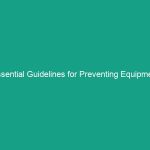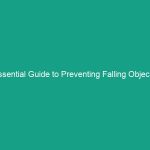Good Morning Team!
Today, we’re diving into an essential topic that affects all of us on the job site: Essential Tips for Preventing Equipment Damage Incidents in Construction. Proper care and handling of our equipment are crucial not just for maintaining productivity but also for ensuring everyone’s Safety. By the end of this Toolbox Talk, you’ll understand why equipment Safety matters and how each of us can contribute to a safer working Environment.
Understanding Equipment Damage Prevention
So, what exactly do we mean by preventing equipment damage incidents in construction? This refers to the practices and Precautions we take to minimize the risk of damaging our machinery, tools, and other vital equipment used in our daily operations. Understanding this concept is vital, as not only does equipment damage lead to costly repairs and downtime, but it can also pose serious safety risks to all team members.
Common misconceptions include the belief that equipment damage is just a part of the job or that certain types of equipment are invulnerable to wear and tear. In reality, neglecting proper handling and Maintenance can lead to severe accidents, injuries, and financial losses. It is imperative to recognize that every small action contributes to the overall safety and efficiency of our operations.
Key Hazards, Risks, and Safety Considerations
In the construction industry, we face numerous Hazards and risks related to equipment usage. Some of the key challenges include:
- Improper Equipment Usage: Using equipment for tasks it was not designed for can lead to mechanical failures.
- Lack of Maintenance: Failing to service equipment regularly can result in unexpected breakdowns.
- Environmental Factors: Weather conditions can impact how equipment operates; for instance, wet surfaces can make machinery slippery.
- Inadequate Training: Without proper training, operators may misuse equipment, leading to accidents.
Ignoring safety protocols can lead to real-world consequences, including serious injuries, project delays, and significant financial repercussions. For example, a single incident of equipment failure can halt construction for days, affecting schedules and budgets.
Best Practices, Procedures, & Actionable Advice
To prevent equipment damage incidents, it’s crucial to implement Best Practices. Here are some actionable steps to follow:
1. Conduct Regular Inspections
Before using any piece of equipment, conduct a thorough inspection. Look for:
- Signs of wear and tear
- Fluid leaks
- Damaged components
- Proper functioning of safety features
By identifying issues early, you can address them before they escalate.
2. Follow Manufacturer Guidelines
Each piece of equipment comes with a manufacturer’s manual that contains important information on usage and maintenance. Always refer to these guidelines and ensure that:
- Equipment is used within its specified limits.
- Maintenance schedules are adhered to.
- All safety features are operational.
3. Implement Proper Training Programs
Ensure all employees operating equipment are adequately trained. Training should cover:
- Equipment Operation
- Emergency Procedures
- Safety protocols
Regular refresher courses will also help keep safety top of mind.
4. Utilize Personal Protective Equipment (PPE)
Always wear the appropriate PPE when operating or working around equipment. This includes:
- Hard hats
- Safety Goggles
- Gloves
- Steel-toed boots
These items can significantly reduce the risk of injury in case of an accident.
5. Develop a Reporting Culture
Encourage team members to report any equipment issues or near-misses immediately. This helps identify patterns and potential hazards before they lead to serious incidents.
Case Study: A Lesson Learned
Consider the case of a construction site where an excavator was used for a task outside its operational limits. The operator had not been trained adequately on the specific model, leading to a catastrophic failure and the machine tipping over. Fortunately, no one was injured, but the project faced significant delays and financial losses due to the incident. This underscores the need for proper training, adherence to limits, and the importance of equipment inspections.
Regulations, Standards, and Compliance
Compliance with safety Standards is not just a legal requirement; it’s essential for protecting yourself and your coworkers. Familiarize yourself with:
- OSHA Regulations related to equipment use
- ISO standards for machinery safety
- Your company’s specific safety protocols
Following these guidelines not only helps keep you safe but also ensures that our company remains compliant with industry standards.
Employee Engagement & Discussion
Now, let’s open the floor for discussion. Think about the last time you encountered an equipment issue. What safety challenges have you faced related to this topic? How can we work together to improve our practices? Sharing our experiences can help us all learn and grow in our safety journey.
Conclusion & Key Takeaways
In conclusion, preventing equipment damage incidents in construction is a shared responsibility that requires vigilance, training, and commitment from all team members. Remember the key points we’ve discussed today:
- Conduct regular inspections.
- Follow manufacturer guidelines.
- Ensure proper training for all operators.
- Wear appropriate PPE.
- Foster a culture of reporting and communication.
Let’s prioritize safety and take these practices to heart. Thank you for your attention and dedication to keeping our workplace safe.


